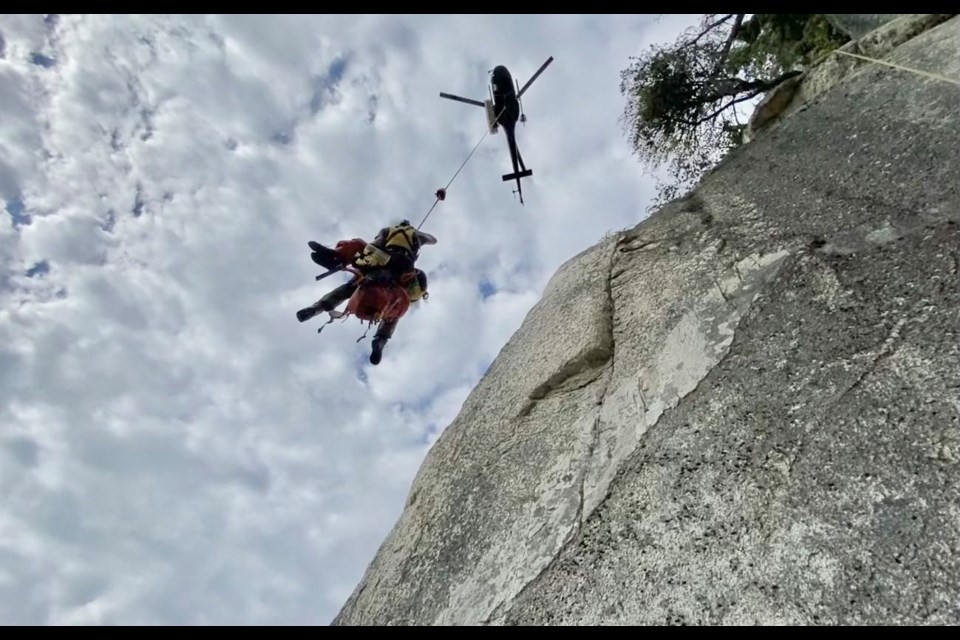For James Dahmer, a volunteer at Squamish Search and Rescue (SSAR), Aug. 15 was just another day on the job when he helped rescue two injured climbers on the Stawamus Chief.
While the rescue involved helicopters, ropes, and quick decisions, for Dahmer and his team at SSAR, it was all about training and teamwork
The rescue, which earned recognition at the Canadian Association of Wilderness Medicine (CAWM) conference, held in Halifax from Nov. 1 to 3, showcased the skill and teamwork of SSAR and their partners.
SSAR is an organization that consists of a “group of volunteers who donate countless hours of personal time to train and respond to emergency situations,” reads their website.
“It feels great to put Squamish Search and Rescue in the spotlight for the work we do,” said Dahmer, who accepted the award on behalf of the team.
“I’m proud to represent the technical skills we bring to the community.”
Climbers in danger on the Stawamus Chief
The rescue involved two climbers from Greece who were struck by a falling boulder while climbing in The Bulletheads section of the Stawamus Chief. Both suffered serious leg injuries.
“The first climber was hit and had bad leg injuries, and then the boulder hit the second climber,” said Dahmer.
Lowered by a helicopter on a long-line, Dahmer climbed down to the injured climbers.
“The helicopter can’t attach to the rock, so I had to use a system where I could secure myself and the climbers safely,” Dahmer said.
He then brought both climbers to safety, one by one.
Rescue strategy: ropes and helicopter support
With little information about the climbers’ exact location, the rescue required careful planning and reconnaissance.
“Unfortunately, given the timeline, we had very little information of where they were,” Dahmer said.
“We had to do a reconnaissance to see what their predicament was like. It’s very time-consuming. They were attached to the rock, injured, for up to four hours. When I arrived on scene, they were in quite a dire state–they had lost a lot of blood, they were very cold, and they weren’t able to have much of a conversation.”
“There was a language barrier as well.”
After securing the climbers, Dahmer carefully transported each of them to a nearby staging area.
“We must transport patients to the nearest road. We can’t go further than that. It’s mandated that the ambulance service transports patients,” said Dahmer.
In this case, critical care paramedics arrived with an air ambulance because the climbers needed to be sent to a trauma centre for surgery.
“We’re supported greatly by Squamish Fire Rescue. We kind of blend our jurisdictions to support each other for these calls,” Dahmer added.
The climbers were taken to Vancouver General Hospital, where their condition remained serious.
“They ended up in Vancouver General. They went through several rounds of surgery. They required a couple of units of blood and stuff like that. So, they were in considerably dire state when I saw them,” Dahmer said.
The rescue required precise co-ordination and planning.
“There’s probably 100 different sequences that need to occur in perfect fashion in order to do that,” Dahmer said.
“While I’m attached to the helicopter and waiting to lift off, I ran through the sequences many, many times in my head to ensure it was well rehearsed.”
“On route to the scene, I focused on finding the safest route in. It was a complex, hybrid response of utilizing ropes as well as the helicopter,” he said.
Commitment to the community
Despite the complexity and urgency of the rescue, Dahmer believes, “There’s nothing heroic about us.”
“We’re regular people, just like anyone else.”
Dahmer, who has been involved in public service since high school—including as a paramedic and with the Canadian Forces—finds meaning in being part of something bigger.
“Always be part of something larger than yourself,” he said.
Dahmer also highlighted the ongoing need for community support and funding for SSAR.
“We always need funding, but we’re committed to keeping our community safe,” he said.
*Please note that this story was corrected after it was first published. The original name of the conference was incorrect. The correct name is: Canadian Association of Wilderness Medicine (CAWM) conference. The Squamish Chief apologizes for this error.
Bhagyashree Chatterjee is The Squamish Chief’s Indigenous affairs reporter. This reporting beat is made possible by the Local Journalism Initiative.



